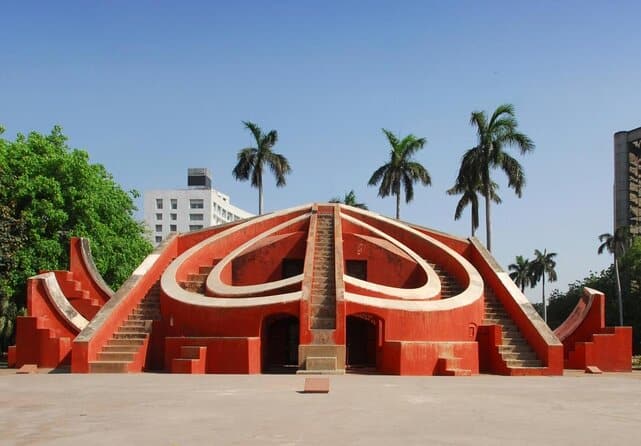Jantar Mantar, the modern name of ‘Yantra Mantra’ which means ‘Instrument with Formula’ is an elaborate and ancient astronomical masterpiece and observatory constructed under the guidance of Maharaja Jai Singh II of Jaipur between 1724 and 1734. The Jantar Mantar Observatory is one of those few Monuments that has been well maintained by the Government of Delhi and attracts tourists and visitors from the entire globe who come to view this ancient astronomical delight and fill their curious minds about the significance of astrology and the usage of the various tools and methods applied during those past centuries for calculations and predictions.
The architecture of Jantar Mantar
The Yantra Mantra also known as Jantar Mantar constitute of 13 astronomy instruments built in the architectural form of huge structures which were, in fact, given as a task to the Maharaja by Mughal Emperor Muhammad Shah in order to revive the astronomical tables and annual calendar and at the same time ensure a medium to record and compile all the astronomical data and future predictions of time coupled with studying the movements of the Sun, Moon and other Planetary bodies.
In the earlier centuries, the astrologers had to manually feed in their calculated predictions using the Yantra Mantra instruments to predict findings and this can only mean that these people would have had to possess a brilliant mind and be outstanding in the field of mathematics, metaphysics and various methods of astronomical studies to depict accurate calculations which today has been made easy partially through computers with built-in software for any prediction and markings though many high-tech instruments are also available for studying planetary movements which definitely require astronomers to possess the thorough knowledge of science. The placard placed in 1910 by the Delhi Tourism Board on this Monumental observatory displays the date of 1710 but research and further investigation revealed that the structures were originally constructed in 1724.
When did Jantar Mantar establish?
The Yantra Mantra or Jantar Mantar was built like a massive equinoctial dial seen with a gigantic triangular-shaped gnomon and the hypotenuse lying parallel to the axis of the Earth and on either side, a quadrant of a circle lies parallel to the plane of the Earth’s equator. This instrument is used to calculate and measure the time during the day along with the decline of the Sun and the planetary bodies. It is noted that this instrument is amazingly accurate missing just by half a second despite the fact that it was the 18th Century we are talking about.
Maharaja Jai Singh Sawai II of Jaipur who constructed this Yantra Mantra (Jantar Mantar) in Delhi is also accredited for constructing similar four other astronomical observatories in Jaipur, Mathura, Ujjain and Varanasi between 1724 and 1735. The name ‘Yantra Mantra’ is derived from the context of calculation and hence is literally translated into ‘A Calculation Instrument’. Each of these calculation instruments within the New Delhi Jantar Mantar Observatory were beautifully named as per their specific purpose and usage for calculations by the King as ‘Samrat Yantra’, ‘Ram Yantra’, ‘Jai Prakash Yantra’ and ‘Mishra Yantra’.
The Samrat Yantra which means ‘Supreme Instrument’ is seen in the shape of a gigantic triangle which represents an equal hour Sun-dial measuring 70 feet in height, 114 feet in length at the base of 10 feet thickness while the Hypotenuse that stretches parallel to the axis of the Earth is 128 feet long. On either side of this hypotenuse is a quadrant along with graduations depicting the hours, the minutes and seconds of the day. Though Sun-dials did exist during that era but this Instrument changed the basic sun-dial into a tool of precision calculation to include the ability to measure the coordinates and declination of other planetary systems.
The Jai Prakash Yantra Instrument is seen in the shape of a hollow hemisphere, with concave surfaces seen with markings inscribed on them. Cross-wires are seen stretching over each point on the surface rim.
The Ram Yantra is another Instrument under which ‘the Ram’ which means ‘the observer’ could sit inside and align the instrument with the position of the stars using various markings or the edge of a window.
The Mishra Yantra Instrument is used to depict the time of noon in were, in various cities across the world and is the only one that was not constructed by Maharaja Jai Singh Sawai II.
Things to keep in mind
- Open: All Days
- Timing: 9.30 a.m. to 5.30 p.m.
- Entry Fee: INR 5 (for Indian citizens) and INR 100 (for foreigners)
- Nearest Metro Station: Patel Chowk
- Photography Charges: Free (Video shoot @ INR 25)
- Video Filming: INR 25
How to reach Jantar Mantar
The nearest metro station to Jantar Mantar is Patel Chowk, from where you can take a cab or an auto-rickshaw to reach. Other metro stations that are close by are Rajiv Chowk and Sansad Marg, which is around 5 mins away from the observatory. If you plan to travel by train, New Delhi Railway Station is the nearest railway station. Alternatively, you can also board a bus to reach it conveniently.
- Guardians of the Game: The Critical Role and Unwavering Necessity of Fraud Verification Companies in Korea’s Toto Ecosystem - February 20, 2024
- Discover These Top Scenic Treks near Delhi - January 31, 2024
- Delhi Travel Tips - June 22, 2021

